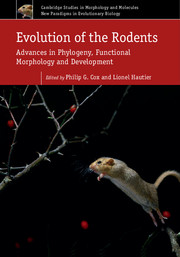Book contents
- Frontmatter
- Contents
- List of contributors
- Foreword
- 1 Rodentia: a model order?
- 2 A synopsis of rodent molecular phylogenetics, systematics and biogeography
- 3 Emerging perspectives on some Paleogene sciurognath rodents in Laurasia: the fossil record and its interpretation
- 4 Phylogeny and evolutionary history of hystricognathous rodents from the Old World during the Tertiary: new insights into the emergence of modern “phiomorph” families
- 5 The history of South American octodontoid rodents and its contribution to evolutionary generalisations
- 6 History, taxonomy and palaeobiology of giant fossil rodents (Hystricognathi, Dinomyidae)
- 7 Advances in integrative taxonomy and evolution of African murid rodents: how morphological trees hide the molecular forest
- 8 Themes and variation in sciurid evolution
- 9 Marmot evolution and global change in the past 10 million years
- 10 Grades and clades among rodents: the promise of geometric morphometrics
- 11 Biogeographic variations in wood mice: testing for the role of morphological variation as a line of least resistance to evolution
- 12 The oral apparatus of rodents: variations on the theme of a gnawing machine
- 13 The muscles of mastication in rodents and the function of the medial pterygoid
- 14 Functional morphology of rodent middle ears
- 15 Variations and anomalies in rodent teeth and their importance for testing computational models of development
- 16 The great variety of dental structures and dynamics in rodents: new insights into their ecological diversity
- 17 Convergent evolution of molar topography in Muroidea (Rodentia, Mammalia): connections between chewing movements and crown morphology
- 18 Developmental mechanisms in the evolution of phenotypic traits in rodent teeth
- 19 Diversity and evolution of femoral variation in Ctenohystrica
- 20 Morphological disparity of the postcranial skeleton in rodents and its implications for palaeobiological inferences: the case of the extinct Theridomyidae (Rodentia, Mammalia)
- Index
- References
18 - Developmental mechanisms in the evolution of phenotypic traits in rodent teeth
Published online by Cambridge University Press: 05 August 2015
- Frontmatter
- Contents
- List of contributors
- Foreword
- 1 Rodentia: a model order?
- 2 A synopsis of rodent molecular phylogenetics, systematics and biogeography
- 3 Emerging perspectives on some Paleogene sciurognath rodents in Laurasia: the fossil record and its interpretation
- 4 Phylogeny and evolutionary history of hystricognathous rodents from the Old World during the Tertiary: new insights into the emergence of modern “phiomorph” families
- 5 The history of South American octodontoid rodents and its contribution to evolutionary generalisations
- 6 History, taxonomy and palaeobiology of giant fossil rodents (Hystricognathi, Dinomyidae)
- 7 Advances in integrative taxonomy and evolution of African murid rodents: how morphological trees hide the molecular forest
- 8 Themes and variation in sciurid evolution
- 9 Marmot evolution and global change in the past 10 million years
- 10 Grades and clades among rodents: the promise of geometric morphometrics
- 11 Biogeographic variations in wood mice: testing for the role of morphological variation as a line of least resistance to evolution
- 12 The oral apparatus of rodents: variations on the theme of a gnawing machine
- 13 The muscles of mastication in rodents and the function of the medial pterygoid
- 14 Functional morphology of rodent middle ears
- 15 Variations and anomalies in rodent teeth and their importance for testing computational models of development
- 16 The great variety of dental structures and dynamics in rodents: new insights into their ecological diversity
- 17 Convergent evolution of molar topography in Muroidea (Rodentia, Mammalia): connections between chewing movements and crown morphology
- 18 Developmental mechanisms in the evolution of phenotypic traits in rodent teeth
- 19 Diversity and evolution of femoral variation in Ctenohystrica
- 20 Morphological disparity of the postcranial skeleton in rodents and its implications for palaeobiological inferences: the case of the extinct Theridomyidae (Rodentia, Mammalia)
- Index
- References
Summary
Introduction
Evo-Devo does not limit itself to the analysis of phenotypic variation and adaptation, but explicitly addresses the generative mechanisms underlying the evolution of organismal form
(Müller, 2007b: p. 502).
Evo-Devo, or Evolutionary Developmental Biology, combines the two independent research disciplines of Evolutionary Biology and Developmental Biology, that re-joined in the late 1970s and early 1980s, after a break of about 100 years after the ‘biogenetic law’ mostly introduced by Haeckel in the 1860s (Arthur, 2002; Churchill, 2007; Gerson, 2007). Evolutionary Biology explores the evolution of forms that have been realised and their variability, and Developmental Biology proposes morphogenetic mechanisms that could have been explored. Müller (2007b) insisted on the emergence of Evo-Devo from the limitations of these two disciplines to explain the form and the structure of the organisms. Since then, the field of Evo-Devo has become one of the most vigorous parts of biology (Gerson, 2007). In recent years, considerable progress has been made in understanding the developmental basis of morphological evolution (Wagner, 2007). However, to become an independent scientific field, Evo-Devo must prove its potential to induce new scientific questions (Müller, 2007a).
Among the new questions that can be assessed by Evo-Devo, is how development contributes to phenotypic novelty (Müller, 2007a). This question raises the problem of homoplasy, i.e. convergence, parallelism and reversals, in evolution. Are the phenotypic novelties generated by developmental mechanisms homologous or homoplastic? Phenotypic novelties are considered homologous if their similarities between taxa are inherited from a common ancestor, whereas homoplastic traits do not share phylogenetic inheritance (Hall, 2003; Wake et al., 2011). Homoplastic traits that share similar developmental, genetic and/or cell-type mechanisms are considered parallel during evolution, corresponding to the concept of deep-homology (Hall, 2003; Shubin et al., 2009). Homoplastic traits that are defined as convergent are usually observed at greater phylogenetic distances than parallel traits, and may not share similar morphogenetic mechanisms.
- Type
- Chapter
- Information
- Evolution of the RodentsAdvances in Phylogeny, Functional Morphology and Development, pp. 478 - 509Publisher: Cambridge University PressPrint publication year: 2015
References
- 11
- Cited by



